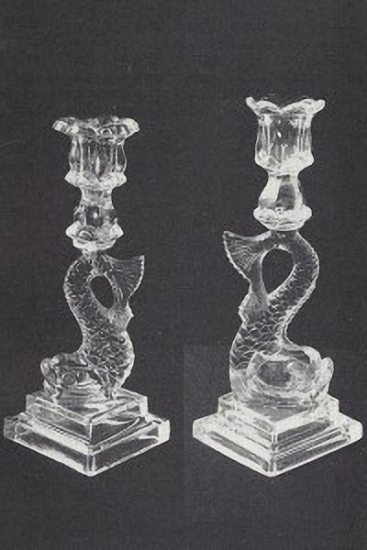Among the earliest items to be sought eagerly by collectors before the great vogue developed for either blown or pressed glass were candlesticks, particularly those known as “dolphin.” Since the demand was great and the supply limited, reproductions duly followed.
Genuine dolphin candlesticks were made both early and late, but it is as easy to differentiate their periods as it is to date costumes. While adequate documentary proof is not available, it is safe to assume that the first specimens of this variety were produced by the Boston & Sandwich Glass Company, perhaps as early as the 1830′s, certainly during the 1840′s.
We have also never hesitated to believe that the first to appear on the market were those with the large, single square base. They are larger, heavier and are found more often in the soft, delicate opaque shades which were more in favor at Sandwich than at any other glassworks.

Next in importance and almost of the same period are those with a double square base. This style was reproduced many years ago and was still being made prior to World War II.
The Pittsburgh type of dolphin candlestick with a hexagonal base has been reproduced in this country in milk-white, though the earliest copy was produced in Bohemia many years ago in sapphire blue, through the efforts of a New England antique dealer.
Illustrated on Plate 128 are an old and a new dolphin candlestick, the reproduction being at the right. Significant differences may be quickly noted.
The genuine dolphin is smaller, the glass is a finer quality of metal, the petals are larger, thicker, and tip slightly over at the top. The new one appears to be made of common window glass. The petals are short and are tilted upward. The old candlestick is ten inches tall, and the new one, ten and one-half inches.
There would be more difficulty in judging the genuine from the spurious, especially for the amateur, in the variety with the double-step base than any of the others, because the old ones were made from different molds at different periods. Even so, the student can always detect the reproductions with a little careful study. Years ago, collectors judged by the misalignment of a seam in the paneled top with the seam in the tail. Early dolphin candlesticks were made in two sections and fused together, thus they were of ten slightly uneven, and the panel seam in the top was hardly ever in line with the center of the seam in the tail.
On the new ones, the seams were always perfectly centered because they were made in a one-piece mold. Later, very clever copies of the old double-step type were made that eliminated the telltale irregularities.
They were turned out in crystal, milk-white, and in combinations of opaque shades, such as white tops and jade green bases, or all green or blue and white, in all of which the makers of these reproductions took care to have the seams vary.
The only way one could tell the old from the new was to compare the finer details. There are some old dolphin candlesticks in which the petal tops are not as thick as those pictured, and do not tip downward as much, but there are no genuine old ones with petals as thin or tilted upward as sharply as the new one pictured here.
A good many of the earliest dolphins were fused together with the addition of a thin wafer of glass. This method was later discarded, and genuine old ones may be found without this wedge-like piece connecting the two parts.

The candlestick on the left of Plate 129 was made on special order for a New England dealer over thirty years ago. This dealer sent a fragment of sapphire blue Sandwich glass to Austria (so the story goes), but it was more likely Bohemia, then a part of Austria-Hungary, so that the right color might be obtained. The new candlesticks may be detected by the quality of the glass and the sharpness of details, especially in the fins. on the fish.
The candlestick at the right in the same illustration is a genuine old one, pictured so that the soft details in the dolphin may be compared with the counterfeit. Dolphin candlesticks having the hexagonal base are not a Sandwich product but were made in the Pittsburgh area, probably during the 1850′s. Many copies are seen of this Pittsburgh type that have been made in this country. They are usually seen in milk-white, though they have been advertised in yellow also, and average from nine to nine and one-half inches in height. This style may also be found in a four-inch size.
Gift shop items in the way of modern dolphin candlesticks which are not a copy of any early type confuse many dealers and collectors. They are now old enough so that families who own them say they “can always remember them,” or “these came to me from Aunt Harriet.” They are anywhere from thirty to thirty-five years old. This type has a round base carrying a diamond pattern, a husky short dolphin and a ribbed socket. They are found in a bright sapphire blue, amber, and probably other colors.
Another strictly modern dolphin candlestick is nine inches tall and has a double-square base, the upper square being quite low in height. The dolphin is mounted on a round pedestal on this second step. These have been out for only a few years and should not deceive any buyer.
Popular collectibles during the 1920′ s were the dolphin compotes together with the matching so-called “petticoat dolphin” candlesticks. They had decorative appeal and lent themselves admirably to interesting dining table arrangements. Four of the candlesticks and a pair of compotes completed a picture. They could be found readily in the days before the vogue for pattern glass swept the country.
The color range included clear to opalescent, yellow-opalescent, blue-opalescent, and a greenish-peacock shade, the last named being the rarest. Today the candlesticks are difficult to find since they are largely in the hands of collectors. Reproductions of the compotes have been on the market for a number of years. Pictured are an old and a new one, the copy being at the left. Differences between them are obvious when shown side by side. Plate 130.

This style of dolphin compote was never made originally in the color combinations of the new one. The base of the copy pictured is in clear glass and the bowl, opaque-blue. As may be clearly seen, the bowl is larger and attached to the base by two wafers of glass.
The old dish was made all in one piece. Other similar reproductions have been seen in curious combinations of colors, such as an opaque-blue bowl and an opaque-cream, or coffee-colored base. These new compotes should never deceive anyone again, after a careful study is made of the accompanying photograph. No reproductions of the petticoat dolphin candlesticks have ever appeared that are worthy of mention.
A style of dolphin compote which should mislead no one is one which has an extra large bowl, weighing down the dolphin, usually seen in milk-white, though sometimes in color. The older of these, which has been on the market for ten or fifteen years, has a deep shell-shaped bowl. The newer type is found in two sizes, seven and eleven inches, and has a dolphin on a hexagonal base supporting a large round bowl. Neither is a copy of an old compote. They are strictly modern, but seem to fool new dealers and collectors.




